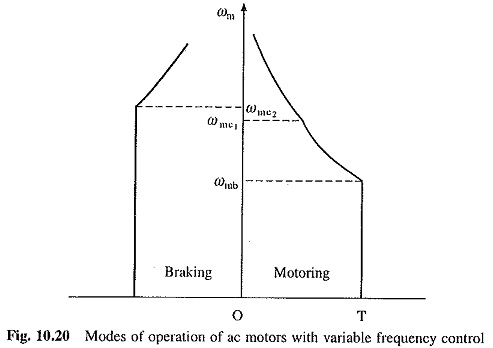Polyphase AC Motors for Traction Drives:
Polyphase AC Motors for Traction Drives – Advantages of ac motors over dc we already know. Because of negligible maintenance, ruggedness and higher power per unit weight or volume, the squirrel-cage induction motor is ideally suitable for traction applications. Because of higher efficiency, and simpler and cheaper inverter, compared to an induction motor, the synchronous motor has also been employed in the traction drives.
Variable frequency control is used both for induction motor and synchronous motor.
Fig. 10.20 shows the modes of operation employed for variable frequency control of an induction motor. From zero to the base speed ωmb, the motor is accelerated at a constant torque, by keeping the V/f ratio constant and increasing it at low speeds. Above the base speed the motor accelerates in the constant power mode with a constant V and variable f.
At a critical speed ωmc1 motor’s break-down-torque limit is reached, therefore, the motor power is gradually reduced by operating it with lesser and lesser stator current. The figure also shows modes of motor operation during braking. From zero to a speed ωmc2 motor is braked at a constant torque. Above ωmc2, the motor is braked at a decreasing braking torque so as to avoid exceeding wheel to rail adhesion capability and to limit the peak power requirements of the drive. Similar curves are obtained in case of synchronous motor.
Several drives employing squirrel-cage induction and synchronous motors are in use in traction. Here only those drives are presented which have received wide acceptance.
